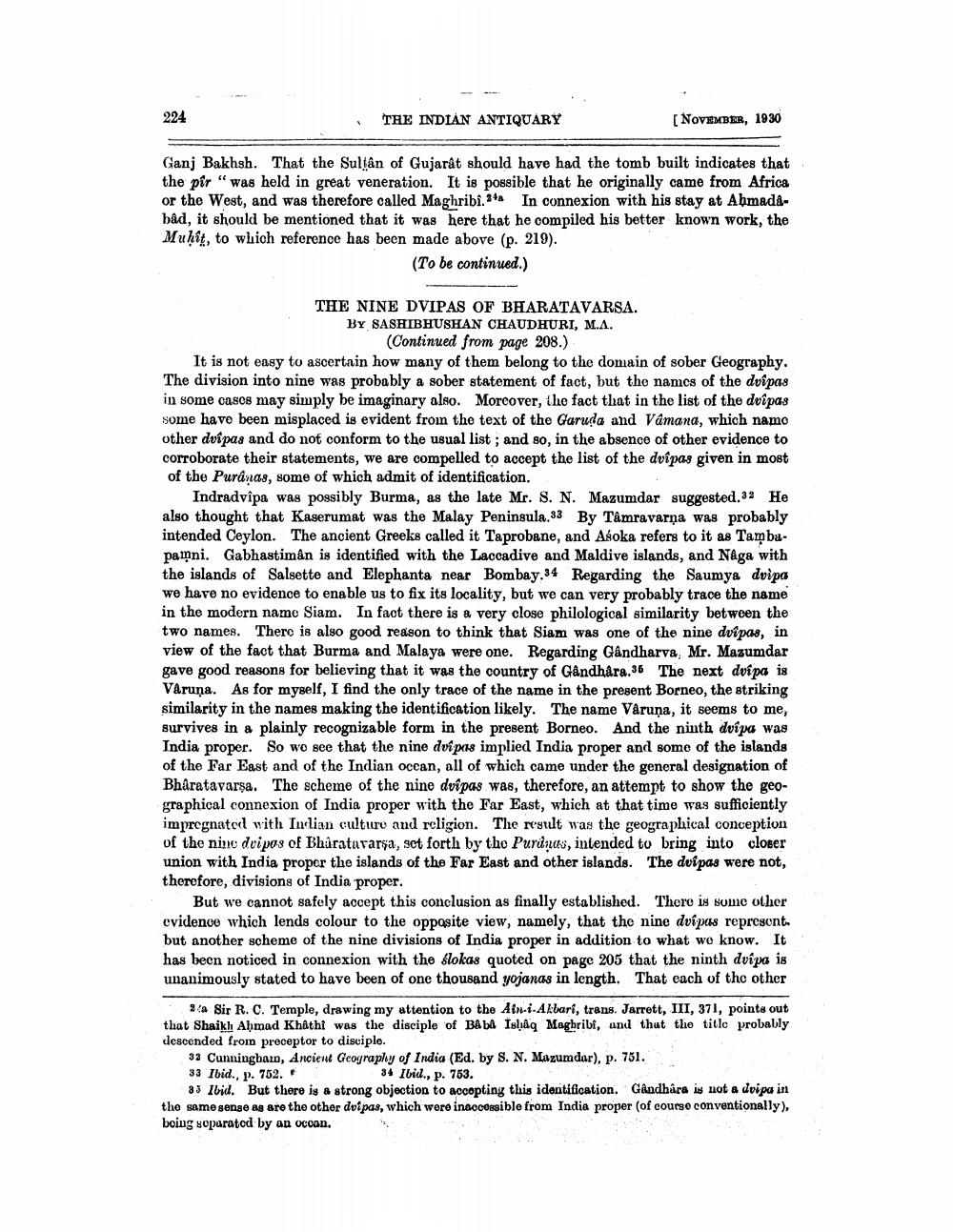________________
224
THE INDIAN ANTIQUARY
[NOVEMBER, 1930
Ganj Bakhsh. That the Sultan of Gujarat should have had the tomb built indicates that the pir "was held in great veneration. It is possible that he originally came from Africa or the West, and was therefore called Maghribi.348 In connexion with his stay at Ahmadabåd, it should be mentioned that it was here that he compiled his better known work, the Muhit, to which reference has been made above (p. 219).
(To be continued.)
THE NINE DVIPAS OF BHARATAVARSA. BY SASHIBHUSHAN CHAUDHURI, M.A.
(Continued from page 208.) It is not easy to ascertain how many of them belong to the domain of sober Geography. The division into nine was probably a sober statement of fact, but the names of the dvipas in some cascs may simply be imaginary also. Moreover, the fact that in the list of the dvipas some have been misplaced is evident froin the text of the Garuda and Vamana, which namo other dvipas and do not conform to the usual list; and so, in the absence of other evidence to corroborate their statements, we are compelled to accept the list of the dvipas given in most of the Puranas, some of which admit of identification.
Indradvîpa was possibly Burma, as the late Mr. S. N. Mazumdar suggested. 32 He also thought that Kagerumat was the Malay Peninsula.33 By Tamravarna was probably intended Ceylon. The ancient Greeks called it Taprobane, and Asoka refers to it as Tambapamni. Gabhastiman is identified with the Laccadive and Maldive islands, and Naga with the islands of Salsette and Elephanta near Bombay.34 Regarding the Saumya dvipa we have no evidence to enable us to fix its locality, but we can very probably trace the name in the modern namo Siam. In fact there is a very close philological similarity between the two names. There is also good reason to think that Siam was one of the nine dvipas, in view of the fact that Burma and Malaya were one. Regarding Gandharva, Mr. Mazumdar gave good reasons for believing that it was the country of Gandhára.36 The next dvípa is Varuņa. As for myself, I find the only trace of the name in the present Borneo, the striking similarity in the names making the identification likely. The name Varuna, it seems to me, survives in a plainly recognizable form in the present Borneo. And the ninth dvípa was India proper. So we see that the nine dvipas implied India proper and some of the islands of the Far East and of the Indian ocean, all of which came under the general designation of Bharatavarşa. The scheme of the nine dvipas was, therefore, an attempt to show the geographical connexion of India proper with the Far East, which at that time was sufficiently impregnated with In-lian culture and religion. The result was the geographical conception of the nine doipos of Bhuratavarşa, set forth by tho Purunas, intended to bring into closer union with India proper the islands of the Far East and other islands. The duí pas were not, therefore, divisions of India proper.
But we cannot safely accept this conclusion as finally established. There is some other evidence which lends colour to the opposite view, namely, that the nine dvipas represent. but another scheme of the nine divisions of India proper in addition to what we know. It has been noticed in connexion with the slokas quoted on page 205 that the ninth dvípa is unanimously stated to have been of one thousand yojanas in length. That each of the other
2[a Sir R. C. Temple, drawing my attention to the Afn-i-Akbari, trans, Jarrett, III, 371, points out that Shaikh Ahmad Khatht was the disciple of Bå bå Islâq Maghribi, and thut the title probably descended from preceptor to disciple.
32 Cunningham, Ancient Geography of India (Ed. by S. N. Mazumdar), p. 751. 33 Ibid., p. 752.
34 Ibid., p. 763. 33 Ibid. But there is a strong objection to accopting this identification. Gandhára is not a dvipa in the same senge ag are the other dvipas, which were inaccessible from India proper (of course conventionally), boing soparated by an ocean.




